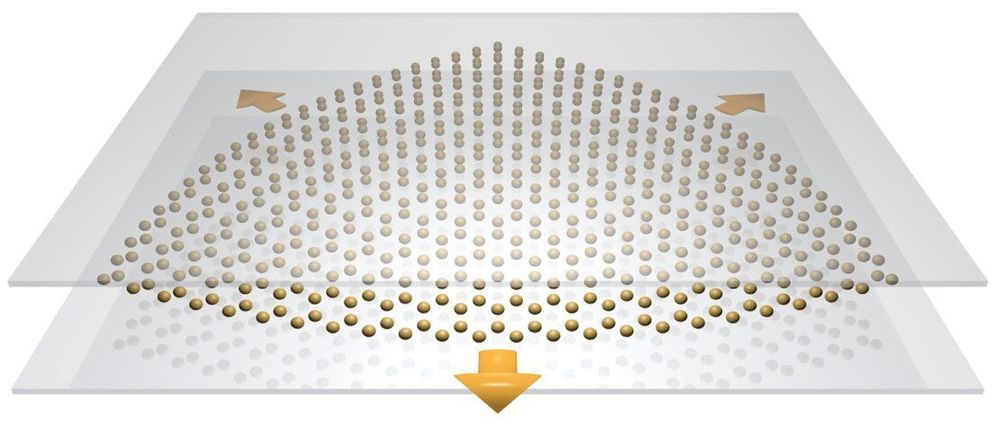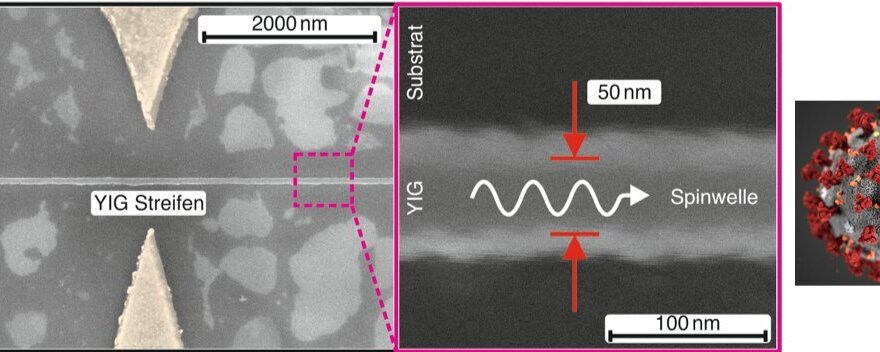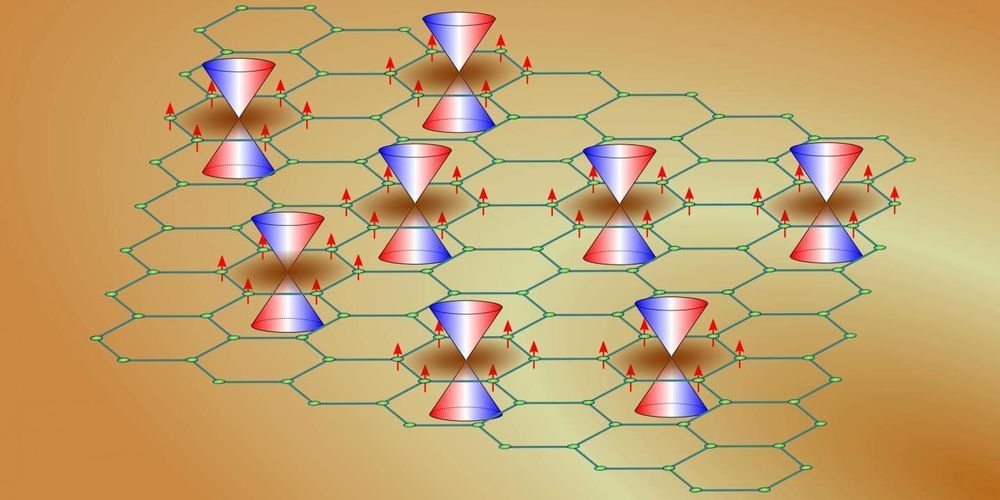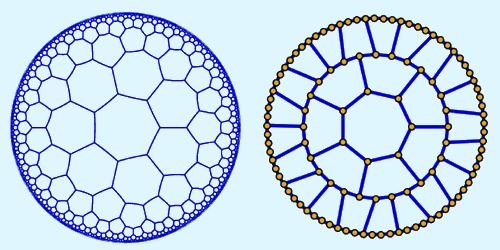A new method promises to capture an elusive dark world particle.
Category: particle physics – Page 523

Physicists ‘trick’ photons into behaving like electrons using a ‘synthetic’ magnetic field
Scientists have discovered an elegant way of manipulating light using a ‘synthetic’ Lorentz force—which in nature is responsible for many fascinating phenomena including the Aurora Borealis.
A team of theoretical physicists from the University of Exeter has pioneered a new technique to create tuneable artificial magnetic fields, which enable photons to mimic the dynamics of charged particles in real magnetic fields.
The team believe the new research, published in leading journal Nature Photonics, could have important implications for future photonic devices as it provides a novel way of manipulating light below the diffraction limit.

Attosecond pulses reveal electronic ripples in molecules
In the first experiment to take advantage of a new technology for producing powerful attosecond X-ray laser pulses, a research team led by scientists from the Department of Energy’s SLAC National Accelerator Laboratory and Stanford University showed they can create electronic ripples in molecules through a process called “impulsive Raman scattering.”
Exploiting this unique interaction will allow scientists to study how electrons zipping around molecules kick off key processes in biology, chemistry, materials science and more. The researchers described their results in Physical Review Letters.
Typically, when X-ray pulses interact with matter the X-rays cause the molecules’ innermost “core” electrons to jump to higher energies. These core-excited states are highly unstable, decaying in just millionths of a billionth of a second. In a majority of X-ray experiments, that’s how the story ends: The excited electrons quickly return to their rightful places by transferring their energy to a neighboring electron, forcing it out of the atom and producing a charged ion.

Spin-Based Quantum Computing Breakthrough: Physicists Achieve Tunable Spin Wave Excitation
Physicists from MIPT and the Russian Quantum Center, joined by colleagues from Saratov State University and Michigan Technological University, have demonstrated new methods for controlling spin waves in nanostructured bismuth iron garnet films via short laser pulses. Presented in Nano Letters, the solution has potential for applications in energy-efficient information transfer and spin-based quantum computing.
A particle’s spin is its intrinsic angular momentum, which always has a direction. In magnetized materials, the spins all point in one direction. A local disruption of this magnetic order is accompanied by the propagation of spin waves, whose quanta are known as magnons.
Unlike the electrical current, spin wave propagation does not involve a transfer of matter. As a result, using magnons rather than electrons to transmit information leads to much smaller thermal losses. Data can be encoded in the phase or amplitude of a spin wave and processed via wave interference or nonlinear effects.

Magnonic nano-fibers opens the way towards new type of computers
o,.o.
Magnetism offers new ways to create more powerful and energy-efficient computers, but the realization of magnetic computing on the nanoscale is a challenging task. A critical advancement in the field of ultralow power computation using magnetic waves is reported by a joint team from Kaiserslautern, Jena and Vienna in the journal Nano Letters.
A local disturbance in the magnetic order of a magnet can propagate across a material in the form of a wave. These waves are known as spin waves and their associated quasi-particles are called magnons. Scientists from the Technische Universität Kaiserslautern, Innovent e. V. Jena and the University of Vienna are known for their expertise in the research field called ‘magnonics,’ which utilizes magnons for the development of novel types of computers, potentially complementing the conventional electron-based processors used nowadays.
“A new generation of computers using magnons could be more powerful and, above all, consume less energy. One major prerequisite is that we are able to fabricate, so-called single-mode waveguides, which enable us to use advanced wave-based signal processing schemes,” says Junior Professor Philipp Pirro, one of the leading scientists of the project. “This requires pushing the sizes of our structures into the nanometer range. The development of such conduits opens, for example, an access to the development of neuromorphic computing systems inspired by the functionalities of the human brain.”

Quirky response to magnetism presents quantum physics mystery
The search is on to discover new states of matter, and possibly new ways of encoding, manipulating, and transporting information. One goal is to harness materials’ quantum properties for communications that go beyond what’s possible with conventional electronics. Topological insulators—materials that act mostly as insulators but carry electric current across their surface—provide some tantalizing possibilities.
“Exploring the complexity of topological materials—along with other intriguing emergent phenomena such as magnetism and superconductivity—is one of the most exciting and challenging areas of focus for the materials science community at the U.S. Department of Energy’s Brookhaven National Laboratory,” said Peter Johnson, a senior physicist in the Condensed Matter Physics & Materials Science Division at Brookhaven. “We’re trying to understand these topological insulators because they have lots of potential applications, particularly in quantum information science, an important new area for the division.”
For example, materials with this split insulator/conductor personality exhibit a separation in the energy signatures of their surface electrons with opposite “spin.” This quantum property could potentially be harnessed in “spintronic” devices for encoding and transporting information. Going one step further, coupling these electrons with magnetism can lead to novel and exciting phenomena.
Joscha Bach — GPT-3: Is AI Deepfaking Understanding?
On GPT-3, achieving AGI, machine understanding and lots more… Will GPT-3 or an equivalent be used to deepfake human understanding?
Joscha Bach on GPT-3, achieving AGI, machine understanding and lots more
02:40 What’s missing in AI atm? Unified coherent model of reality
04:14 AI systems like GPT-3 behave as if they understand — what’s missing?
08:35 Symbol grounding — does GPT-3 have it?
09:35 GPT-3 for music generation, GPT-3 for image generation, GPT-3 for video generation
11:13 GPT-3 temperature parameter. Strange output?
13:09 GPT-3 a powerful tool for idea generation
14:05 GPT-3 as a tool for writing code. Will GPT-3 spawn a singularity?
16:32 Increasing GPT-3 input context may have a high impact
16:59 Identifying grammatical structure & language
19:46 What is the GPT-3 transformer network doing?
21:26 GPT-3 uses brute force, not zero-shot learning, humans do ZSL
22:15 Extending the GPT-3 token context space. Current Context = Working Memory. Humans with smaller current contexts integrate concepts over long time-spans
24:07 GPT-3 can’t write a good novel
25:09 GPT-3 needs to become sensitive to multi-modal sense data — video, audio, text etc
26:00 GPT-3 a universal chat-bot — conversations with God & Johann Wolfgang von Goethe
30:14 What does understanding mean? Does it have gradients (i.e. from primitive to high level)?
32:19 (correlation vs causation) What is causation? Does GPT-3 understand causation? Does GPT-3 do causation?
38:06 Deep-faking understanding
40:06 The metaphor of the Golem applied to civ
42:33 GPT-3 fine with a person in the loop. Big danger in a system which fakes understanding. Deep-faking intelligible explanations.
44:32 GPT-3 babbling at the level of non-experts
45:14 Our civilization lacks sentience — it can’t plan ahead
46:20 Would GTP-3 (a hopfield network) improve dramatically if it could consume 1 to 5 trillion parameters?
47:24 GPT3: scaling up a simple idea. Clever hacks to formulate the inputs
47:41 Google GShard with 600 billion input parameters — Amazon may be doing something similar — future experiments
49:12 Ideal grounding in machines
51:13 We live inside a story we generate about the world — no reason why GPT-3 can’t be extended to do this
52:56 Tracking the real world
54:51 MicroPsi
57:25 What is computationalism? What is it’s relationship to mathematics?
59:30 Stateless systems vs step by step Computation — Godel, Turing, the halting problem & the notion of truth
1:00:30 Truth independent from the process used to determine truth. Constraining truth that which can be computed on finite state machines
1:03:54 Infinities can’t describe a consistent reality without contradictions
1:06:04 Stevan Harnad’s understanding of computation
1:08:32 Causation / answering ‘why’ questions
1:11:12 Causation through brute forcing correlation
1:13:22 Deep learning vs shallow learning
1:14:56 Brute forcing current deep learning algorithms on a Matrioshka brain — would it wake up?
1:15:38 What is sentience? Could a plant be sentient? Are eco-systems sentient?
1:19:56 Software/OS as spirit — spiritualism vs superstition. Empirically informed spiritualism
1:23:53 Can we build AI that shares our purposes?
1:26:31 Is the cell the ultimate computronium? The purpose of control is to harness complexity
1:31:29 Intelligent design
1:33:09 Category learning & categorical perception: Models — parameters constrain each other
1:35:06 Surprise minimization & hidden states; abstraction & continuous features — predicting dynamics of parts that can be both controlled & not controlled, by changing the parts that can be controlled. Categories are a way of talking about hidden states.
1:37:29 ‘Category’ is a useful concept — gradients are often hard to compute — so compressing away gradients to focus on signals (categories) when needed
1:38:19 Scientific / decision tree thinking vs grounded common sense reasoning
1:40:00 Wisdom/common sense vs understanding. Common sense, tribal biases & group insanity. Self preservation, dunbar numbers
1:44:10 Is g factor & understanding two sides of the same coin? What is intelligence?
1:47:07 General intelligence as the result of control problems so general they require agents to become sentient
1:47:47 Solving the Turing test: asking the AI to explain intelligence. If response is an intelligible & testable implementation plan then it passes?
1:49:18 The term ‘general intelligence’ inherits it’s essence from behavioral psychology; a behaviorist black box approach to measuring capability
1:52:15 How we perceive color — natural synesthesia & induced synesthesia
1:56:37 The g factor vs understanding
1:59:24 Understanding as a mechanism to achieve goals
2:01:42 The end of science?
2:03:54 Exciting currently untestable theories/ideas (that may be testable by science once we develop the precise enough instruments). Can fundamental physics be solved by computational physics?
2:07:14 Quantum computing. Deeper substrates of the universe that runs more efficiently than the particle level of the universe?
2:10:05 The Fermi paradox
2:12:19 Existence, death and identity construction.


Quantum Simulations of Curved Space
A heptagonal-lattice superconducting circuit, and the mathematics that describe it, provide tools for studying quantum mechanics in curved space.
According to John Wheeler’s summary of general relativity, “space-time tells matter how to move; matter tells space-time how to curve.” How this relationship plays out at the quantum scale is not known, because extending quantum experiments to curved space poses a challenge. In 2019, Alicia Kollár and colleagues at Princeton University met that challenge with a photonic circuit that represents the negatively curved space of an expanding universe [1]. Now, Igor Boettcher and colleagues at the University of Maryland, College Park, describe those experiments with a new theoretical framework [2]. Together, the studies offer a toolkit for studying quantum mechanics in curved space that could help answer fundamental questions about cosmology.
In a universe that expands at an accelerating rate, space curves away from itself at every point, producing a saddle-like, hyperbolic geometry. To project hyperbolic space onto a plane, Kollár’s team etched a centimeter-sized chip with superconducting resonators arranged in a lattice of heptagonal tiles. By decreasing the tile size toward the edge of the chip, the researchers reproduced a perplexing property of hyperbolic space: most of its points exist on its boundary. As a result, photons moving through the circuit behave like particles moving in negatively curved space.
Center Will Focus on Neutron Star Modeling in ‘Gravitational Wave Era’
This rendering shows the density of matter in the aftermath of two merged neutron stars, resulting in the formation of a black hole. (Credit: David Radice/Pennsylvania State University)
A new Physics Frontier Center at UC Berkeley, supported by the National Science Foundation, expands the reach and depth of existing capabilities on campus and at neighboring Lawrence Berkeley National Laboratory (Berkeley Lab) in modeling one of the most violent events in the universe: the merger of neutron stars and its explosive aftermath.
The Network for Neutrinos, Nuclear Astrophysics, and Symmetries (N3AS) Physics Frontier Center is led by Wick Haxton, a theoretical nuclear physicist in Berkeley Lab’s Nuclear Science Division, astrophysicist, and UC Berkeley physics professor.